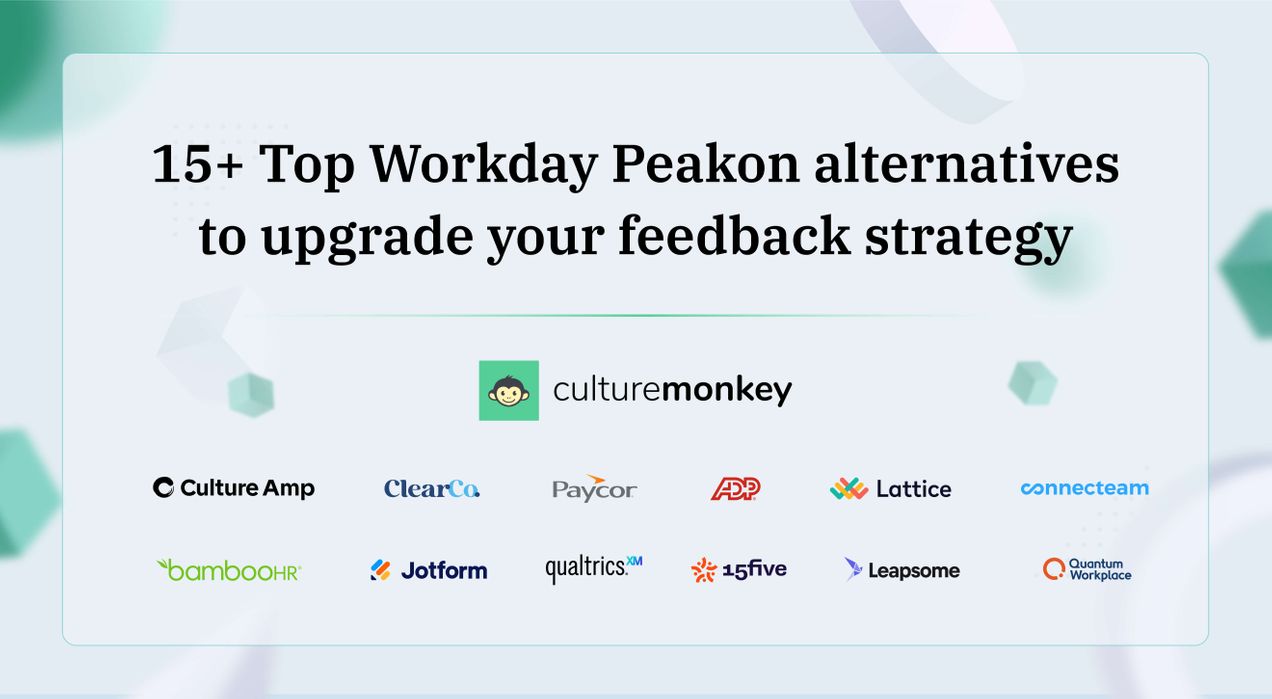Employee engagement survey: Common mistakes and how to avoid them

"The greatest danger in times of turbulence is not the turbulence itself, but to act with yesterday's logic." - Peter Drucker
As we delve into the topic of employee engagement surveys, this insightful quote by Peter Drucker reminds us of the importance of adapting our strategies to meet the demands of an ever-changing workplace.
Employee engagement surveys serve as a powerful tool for organizations to understand their workforce, foster a culture of open communication, and drive positive change.
However, it's all too common for well-intentioned organizations to make mistakes when conducting these surveys, inadvertently undermining their impact. But fear not! In this blog, we're here to equip you with the knowledge and guidance to avoid these pitfalls and optimize the outcomes of your employee engagement surveys.
Whether you're an entrepreneur, a team leader, or an HR professional, this blog offers practical insights and actionable tips to help you navigate the intricacies of conducting effective surveys. So, let's break free from outdated approaches, embrace fresh thinking, and embark on a journey toward enhanced employee engagement.
Ready? Let's get started!
Table of contents:-
- What are employee engagement surveys?
- Common problems with employee engagement surveys that employees face
- Top 10 mistakes to avoid while conducting employee engagement surveys to measure employee engagement
- What are the key things that should be in every employee engagement survey questions?
- Why just conducting employee engagement surveys isn’t enough?
- The significance of an employee engagement survey tool in measuring and improve employee engagement
- Conclusion
- FAQs
What are employee engagement surveys?

Employee engagement surveys are systematic tools used by organizations to measure employee engagement and satisfaction among their employees. These surveys typically consist of a series of questions designed to gather feedback and insights from employees about various aspects of their work experience, including job satisfaction, communication, work-life balance, professional development opportunities, organizational and company culture, and more.
The primary purpose of employee engagement surveys is to gauge the overall level of employee engagement within an organization. Employee engagement refers to the extent to which employees are emotionally invested in their work, committed to the organization's goals, and motivated to contribute their best efforts.
High employee engagement and engaged workplace has been linked to improved productivity, increased employee retention, enhanced customer satisfaction, and overall organizational success.
By collecting feedback through surveys, organizations can identify areas where they are excelling and areas that need improvement. The insights gathered from these surveys can help inform strategic decisions, drive initiatives to enhance employee engagement and foster a positive work environment that aligns with employees' needs and aspirations.
In summary, employee engagement surveys are invaluable tools that enable organizations to assess and enhance employee engagement, leading to a more productive, satisfied, and successful workforce.
Common problems with employee engagement surveys that employees face

While employee engagement surveys can be a valuable tool for organizations, there are common problems that employees may face when participating in these surveys.
Understanding these challenges is crucial for organizations to both address employee feedback and ensure the effectiveness of their survey efforts. Here are some common problems employees may encounter:
Lack of anonymity
Employees may hesitate to provide honest feedback if they feel their responses can be traced back to them. Concerns about potential repercussions or the fear of being identified can lead to incomplete or inaccurate responses.
Survey fatigue
If organizations frequently administer surveys without clear communication on the purpose and impact of the surveys, employees may experience survey fatigue. This can result in reduced participation and less thoughtful responses.
Ambiguous or irrelevant questions
Poorly designed employee survey questions or questions that do not align with employees' experiences can lead to confusion or frustration. Employees may struggle to provide meaningful responses when questions are unclear or not relevant to their work.
Survey overload
Employees may face an overload of surveys from various departments or initiatives within the organization. This can lead to survey fatigue and a diminished willingness to participate fully in each survey.
Language or accessibility barriers
Employees who are non-native english speakers or have disabilities may face challenges in understanding and completing surveys if they are not provided in their preferred language or accessible formats.
Limited opportunity for qualitative feedback
Surveys often focus on quantitative measures, such as rating scales, which may not capture the full range of employee experiences and insights. Employees may feel limited in expressing their thoughts and suggestions.
To address these problems, organizations should prioritize anonymous surveys, communicate the purpose and impact of surveys, design clear and relevant questions, demonstrate commitment to follow-up actions, minimize survey frequency, accommodate diverse needs, and provide opportunities for qualitative feedback.
By addressing these challenges, organizations can create a more inclusive and effective employee engagement survey process.
Top 10 mistakes to avoid while conducting employee engagement surveys to measure employee engagement

When conducting employee engagement surveys, it's important to be aware of common mistakes that can undermine their effectiveness. By avoiding these pitfalls, organizations can ensure that their surveys provide accurate insights and drive meaningful improvements. Here are the top 10 mistakes to avoid:
Lack of clear objectives
Failing to establish clear objectives for the survey can result in vague or irrelevant questions, making it difficult to gather actionable insights.
Insufficient communication
Inadequate communication about the purpose, confidentiality, and impact of the survey can lead to low participation rates and skepticism among employees.
Lengthy and complex surveys
Long, complex surveys can lead to survey fatigue and reduced quality of responses. Keeping surveys concise and focused increases participation and engagement. You should consider using pulse surveys as a workaround!
Neglecting anonymity
Failing to ensure anonymity can discourage employees from providing honest feedback, leading to skewed results. Employers should guarantee confidentiality to further encourage employees' open and candid responses.
Ignoring demographic diversity
Neglecting to consider demographic diversity in survey design can result in biases and overlook unique experiences and perspectives of different employee groups.
Lack of follow-up actions
Collecting data without following up with action plans and communicating results can lead to employee disengagement and a sense of futility regarding survey participation.
Overlooking survey feedback
Dismissing or disregarding employee feedback without addressing concerns or implementing changes can erode trust and discourage future participation.
Inflexible survey frequency
Administering surveys too frequently or infrequently can both be problematic. Finding the right balance ensures that surveys provide meaningful data without overwhelming employees.
Failing to analyze data comprehensively
Collecting data is only the first step. Organizations must dedicate time and resources to analyze survey results thoroughly to gain meaningful insights.
Lack of transparency
Failing to share survey results and improvements made based on employee feedback can create a perception of secrecy and undermine trust in the survey process.
What are the key things that should be in every employee engagement survey questions?

Overall satisfaction
Include questions that measure employee engagement and their overall satisfaction with their work and the organization. This provides the team members a baseline understanding of employee sentiment.
Communication and feedback
Assess the effectiveness of internal communication channels and opportunities for employees to provide feedback, ensuring that their voices are heard and valued.
Job satisfaction
Evaluate employees' satisfaction with their specific roles, responsibilities, workload, and opportunities for growth and development.
Leadership and management
Gather feedback on employees' perceptions of leadership, management style, and the extent to which they feel supported, valued, and motivated by their supervisors.
Teamwork and collaboration
Assess the level of teamwork, collaboration, and cooperation among employees, as well as their sense of belonging and camaraderie within their teams.
Work-life balance
Include questions that explore employees' perceptions of work-life balance, their ability to manage personal and professional commitments, and the organization's support in achieving a healthy balance.
Organizational culture
Measure employees' perceptions of the organization's values, ethics, inclusivity, and commitment to diversity, equity, and inclusion.
Recognition and rewards
Evaluate whether employees feel recognized and appreciated for their contributions, and if the organization offers appropriate rewards and incentives.
Training and development
Assess the availability and effectiveness of training programs, opportunities for skill development, and career advancement prospects within the organization.
Employee well-being
Include questions about employees' physical and mental well-being, workload stressors, and the support available to address their well-being needs.
Additionally, provide an opportunity for open-ended comments or suggestions, allowing employees to provide qualitative feedback on any additional topics they deem important.
By including these key elements in an annual employee engagement survey, organizations can gain comprehensive insights into various aspects of employee experience and engagement.
Why just conducting employee engagement surveys isn’t enough?

While conducting employee engagement surveys is a valuable step towards understanding employee satisfaction and driving positive change, it's important to recognize that surveys alone are not enough to create a truly engaged workforce. Here's why:
Action is key
Employee engagement surveys provide insights into areas of improvement, but without taking meaningful action based on the survey results, the impact remains limited. It's essential for organizations to develop action plans, communicate them to employees, and follow through with concrete steps to address identified issues.
Ongoing communication
Surveys capture a snapshot of employee sentiment at a specific moment, but employee engagement is a dynamic and ongoing process.
Regular communication channels such as team meetings, one-on-one discussions, and feedback sessions are crucial for maintaining engagement and fostering a culture of open communication beyond the survey.
Employee involvement
Engaging employees goes beyond simply asking for their feedback. Involving employees in decision-making processes, giving them opportunities to contribute ideas, and empowering them to take ownership of their work fosters a sense of ownership and commitment.
Leadership commitment
Employee engagement is greatly influenced by leadership behavior and practices. It's vital for senior leaders to to demonstrate genuine care for employee well-being, provide support, and lead by example to create a positive work environment that fosters engagement.
Continuous improvement
Employee engagement is not a one-time initiative. It requires continuous evaluation, adaptation, and improvement. Organizations should regularly assess the impact of their engagement initiatives, monitor progress, and make necessary adjustments to ensure sustained engagement over time.
Holistic approach
Employee engagement is influenced by various factors, including work-life balance, career development, organizational culture, and recognition.
While surveys provide insights into specific areas, it's important to adopt a holistic approach that addresses all these aspects to create a truly engaging work environment.
Remember, employee engagement surveys are just one tool in the larger context of fostering employee engagement. It's the combination of surveys, active listening, open communication, leadership commitment, and continuous improvement that truly creates an engaged and thriving workforce.
The significance of an employee engagement survey tool in measuring and improve employee engagement

An employee engagement survey tool holds significant importance in measuring and improving employee engagement within organizations. Here are the key reasons why this tool is significant:
Quantitative measurement
The survey tool provides a quantitative measure of employee engagement. It allows organizations to collect data and metrics that objectively quantify the level of engagement among employees. This data serves as a baseline for analysis and comparison over time.
Insight into employee perceptions
The survey tool offers a platform for employees to express their perceptions, opinions, and experiences related to their work environment. It provides valuable insights into what motivates employees, their level of satisfaction, and areas that may require attention.
Identifying strengths and areas for improvement
By analyzing the survey results, organizations can identify the strengths and weaknesses in their employee engagement initiatives.
The tool highlights areas where the organization is excelling and areas that need improvement, allowing targeted actions to enhance engagement.
Benchmarking and comparison
Employee engagement survey tools often include benchmarking capabilities, enabling organizations to compare their employee engagement survey results with industry standards or other similar organizations.
This helps business leaders gauge the organization's performance and identify areas where improvements are necessary to stay competitive.
Facilitating actionable change
The survey tool serves as a catalyst for change. It provides evidence-based data that supports decision-making and guides the development of strategies and initiatives to enhance employee engagement.
The tool helps organizations prioritize actions based on identified needs and empowers them to make informed changes.
Employee involvement and empowerment
The survey tool demonstrates that employee opinions and perspectives are valued. It creates a sense of involvement and empowerment by giving employees a voice in shaping the organization's culture, policies, and practices. This, in turn, fosters a greater sense of ownership and commitment among employees.
Monitoring progress and long-term impact
Regularly administering the survey tool allows organizations to track progress and measure the impact of their engagement initiatives over time. It helps monitor trends, identify areas of improvement, and assess the effectiveness of implemented actions.
Overall, an employee engagement survey tool is a valuable resource that enables organizations to measure, understand, and improve employee engagement.
Conclusion
An employee engagement survey tool plays a crucial role in measuring and improving employee engagement within organizations. It provides a quantitative measure of employee satisfaction, identifies areas for improvement, and empowers organizations to take actionable steps towards enhancing engagement.
By leveraging the insights gained from these surveys, organizations can create a positive work environment, boost employee morale, and drive productivity and business success.
To unlock the full potential of employee engagement surveys, consider partnering with employee engagement survey software from CultureMonkey. With its user-friendly survey platform and expert guidance, CultureMonkey offers a comprehensive solution to measure, analyze, and improve employee engagement.
Their customizable surveys, insightful analytics, and actionable recommendations empower organizations to create a culture of engagement and elevate employee satisfaction.
Don't miss out on the opportunity to enhance your organization's employee performance, and create a thriving work environment. Visit CultureMonkey to learn more and embark on a journey towards unlocking the full potential of your workforce through employee engagement surveys.
Schedule a demo today!
FAQs
What is an employee engagement survey?
An employee engagement survey is a tool used by organizations to measure the level of engagement and satisfaction among employees. It typically includes a set of questions designed to gather feedback on various aspects of the work environment, leadership, and overall employee experience.
What are good employee engagement questions?
Good employee engagement questions focus on key areas such as job satisfaction, communication, leadership, teamwork, recognition, and growth opportunities. Examples include "Do you feel valued and appreciated in your role?" and "Do you have clear goals and expectations?"
What are the 4 E's of employee engagement?
The 4 E's of employee engagement refer to the key components and drivers of engagement: Energy (physical, emotional, and cognitive), Engagement (being fully absorbed and involved in work), Enthusiasm (having a positive attitude and passion), and Empowerment (feeling valued and having autonomy in decision-making).
What is KPI for the employee engagement survey?
Key Performance Indicators (KPIs) for employee engagement surveys may include metrics like overall engagement score, employee satisfaction ratings, retention rates, productivity levels, and participation in company initiatives. These indicators help track progress, identify areas for improvement, and measure the impact of engagement initiatives.
What is the best scale for an employee engagement survey?
The best scale for an employee engagement survey is a 5-point Likert scale ranging from "Strongly Disagree" to "Strongly Agree." This scale allows for a balanced range of responses and clarifies employees' agreement or disagreement with the survey statements.



